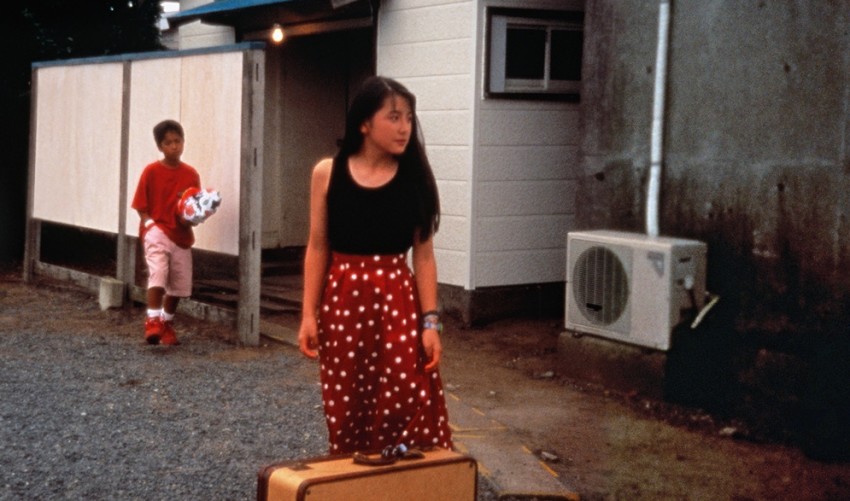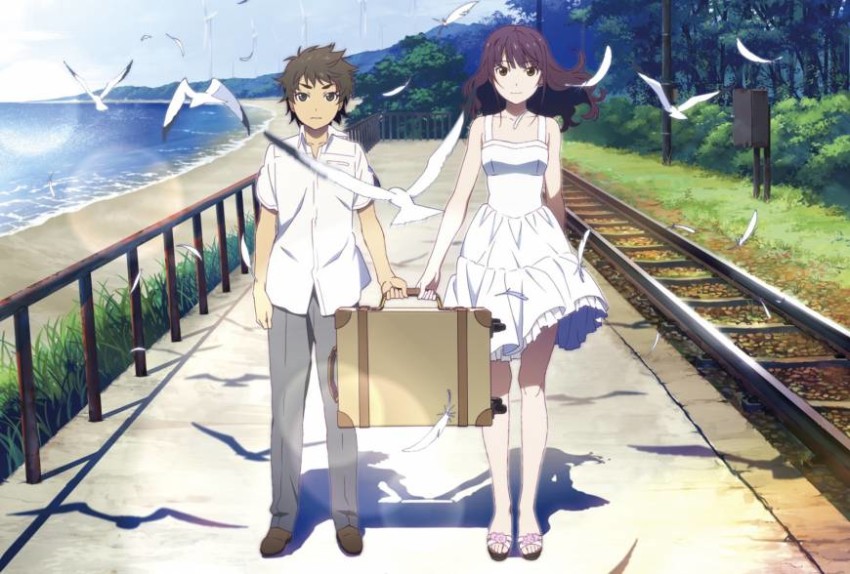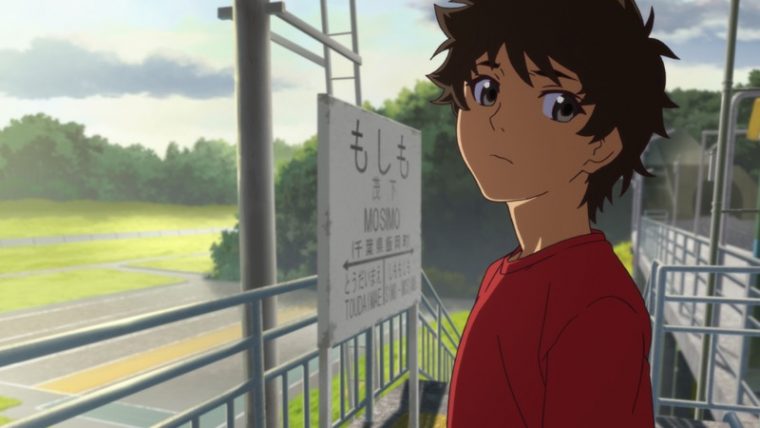Fireworks
October 9, 2017 · 0 comments
By Jonathan Clements.
School’s out for summer, but most of the boys are too deeply involved in an argument about fireworks to notice the drama unfolding elsewhere. Nazuna (Suzu Hirose), their prettiest classmate, won’t be coming back in the new term – her mother is remarrying and moving to a new town, and plans to take her along. Determined to escape, Nazuna instead plans to elope with a local boy. At a fateful meeting at a swimming pool, she secretly decides to choose whoever wins the next race…
The original live-action Fireworks, Should We See it from the Side or the Bottom? was a watershed moment for the young Shunji Iwai. Originally commissioned as part of a series of 49-minute TV movies on the theme of “What if…”, its broadcast in the summer of 1993 secured Iwai a Best Newcomer Award from the Directors Guild of Japan. Shot with an “F-effect” process that made video look more like film, it was subsequently re-cut and released in cinemas. “Forever Friends”, the song which played over the climactic scene (and is reprised in the anime) was a slow-burning hit, released several years later after a growing demand for a CD version.
 The “What If…” series, of which the live-action Fireworks was the 16th of 18 broadcasts, was rooted in a growing awareness of game-style branching narratives, particularly after the release of Groundhog Day that same year. Each story hinged upon a crucial decision, forking into two alternate outcomes. Other films in the series included such high-concept titles as Marry the Heiress or the Girl Next Door?, Bully or Best Friend at the Class Reunion?, Break Up or Get Married? – set among such clearly critical moments, Iwai’s question of whether to watch a fireworks display from one position or another allied itself with several other works that offered seemingly mundane dilemmas, including Should She Sit on the Right or the Left? and Summer Hairstyle: Long or Short? However, the title was a red herring, since it ignores the fact that the decision Nazuna faces is substantially grander and more life-changing, and itself reflects a whole bunch of even more agonising choices that her mother had to make off-screen.
The “What If…” series, of which the live-action Fireworks was the 16th of 18 broadcasts, was rooted in a growing awareness of game-style branching narratives, particularly after the release of Groundhog Day that same year. Each story hinged upon a crucial decision, forking into two alternate outcomes. Other films in the series included such high-concept titles as Marry the Heiress or the Girl Next Door?, Bully or Best Friend at the Class Reunion?, Break Up or Get Married? – set among such clearly critical moments, Iwai’s question of whether to watch a fireworks display from one position or another allied itself with several other works that offered seemingly mundane dilemmas, including Should She Sit on the Right or the Left? and Summer Hairstyle: Long or Short? However, the title was a red herring, since it ignores the fact that the decision Nazuna faces is substantially grander and more life-changing, and itself reflects a whole bunch of even more agonising choices that her mother had to make off-screen.
As a writer, Iwai displayed substantially greater interest in one outcome than the other, leading to complaints from the crew-members charged with making the alternate storyline. This tension between his original aims and the framing of the series can still be seen today, with the publication of two novelisations of the anime – one by scenarist Hitoshi Ohne, the other by Iwai himself, pointedly clinging to his original title, The Boys Wanted to See Fireworks from the Side.
The most obvious change from the original is the decision to move up the ages of the leads to fifteen in the anime version. “If the boys were still in elementary school, it would have made them too childish, and frankly harder to perform in a script for animation,” director Akiyuki Shinbo told the Japanese site MyNavi. “And I think there’s a palpable difference between the last year of elementary school and the first year of middle school. It’s when the girls grow up and get taller, and I thought that would help emphasise the tensions of the original.” This was certainly an issue spotted by Mark Schilling of the Japan Times, who praised the “unusual realism” of the film in portraying Norimichi (Masaki Suda) as “a head shorter than Nazuna, the fate of many a seventh-grade male.”
Arguably, this remake may suffer from resembling many more recent films, inspired at least in part by Iwai’s earlier work. Modern anime fans may see echoes of Makoto Shinkai’s second-chances drama Your Name, but also the multiple do-overs of Mamoru Hosoda’s The Girl Who Leapt Through Time, itself a remake of a much-loved classic. Tearing a leaf from Hosoda’s film, the anime Fireworks presents not the either/or story of the original, but multiple sequences of respawns and retries. This transforms the latter part of the film into a series of branching possibilities that celebrates anime’s ability to conceive new worlds and new angles.
Producer Genki Kawamura expected sparks to fly between the main staff members, particularly since Iwai the original writer-director was sitting in with Shinbo the animator and screenwriter Hitoshi Ohne, himself no stranger to helming his own films. “It was very exciting sitting in a script meeting with three directors,” Kawamura told Japan’s Buzz Feed. “Punches could fly at you from any direction.” Shinbo, however, blew Kawamura’s mind early on, by suggesting that the artwork for the characters unobtrusively depicted them as a little bit younger every time they backtracked – something only possible in animation.
For Shunji Iwai, the original writer-director, now happily side-lined as a consultant and observer, the sight of the finished anime was a series of surprises. “I didn’t expect them to reproduce some of the shots so exactly,” he told a Japanese web magazine. “There were places where they were almost tracing over the original, so I guess I looked upon that as the ultimate tribute. But beyond that, I was taken with the portrayal of Nazuna, the heroine, which was an inventive expression completely different from my approach.”
A lot has changed in the 24 years since Iwai’s live-action original. As with his Hana and Alice, the first film was a springboard for its leads’ careers. Yuuta Yamazaki and Takayuki Sorita, who first played Norimichi and Yusuke, went on to become stars in Japanese TV and film. Megumi Okina, the original Nazuna, subsequently found international fame in The Grudge. None of them, however, return for this remake, even in cameos. Unlike The Case of Hana and Alice anime, which lured back its former leads to voice motion-capture by younger actresses, the anime cast is all-new and strongly linked to today’s live-action media circus, including former Kamen Rider Masaki Suda, Mamoru Miyano from the Death Note movies, and Suzu Hirose from the Chihayafuru films. Like the leads in The Case of Hana and Alice, Miyano in particular is able to hide behind animation to his advantage – it is difficult to imagine even his famously youthful good looks allowing him to otherwise get away with playing a 15-year-old schoolboy at 34.
The central question posed by the title is an oddly technical discussion. When fireworks go off, is the explosion two- or three-dimensional? Does the big explosion blast outwards like a sphere, or a disc? It’s the sort of thing one can imagines animators feverishly testing, particularly when the spatial footprint of a firework display can be modelled exactly as part of the modern process of animation. Even the opening titles playfully acknowledge the “materiality” of animation, with explosions illuminating stark silhouettes of the local landscape, and also briefly revealing the names of the cast and crew. The nature of the space inside a frame of animation, whether it exists as a flat drawing or a three-dimensional model, is a popular topic of discussion for animators, particularly in the modern industry, where the two modes are often forced to co-exist. Director Shinbo even makes a visual joke of it, tracking his virtual camera through the 3D space of a circular school hall, even as the characters inside it bicker about whether images are flat or filled-out. But Nazuna herself wanders through the scene disdainfully, making a silent comment on the pointlessness of such laddish debate in a world where the boys might do better to notice her.
Nazuna is the most three-dimensional of the characters, a fact first made clear by her sullen, quiet interactions with her would-be stepfather. She is still enough of a child to take him up on his offer of ice cream, but still enough of a teenager not to thank him. More notably, her ideas about running away are ridiculously unrealistic and sure to end in tears – a fact most obvious as she shyly speculates about all the golden opportunities awaiting a 15-year-old runaway in the big city. Nazuna’s mask of perfection and purity starts to slip, and she is revealed to be fallible, deluded, even manipulative. She becomes a fuller, more rounded character as the film goes on, but in doing so, she loses the sheen of perfection that Norimichi has previously assigned to her. She plainly hasn’t thought much further than packing a suitcase and getting on a train, a fact revealed to both her and Norimichi in a fairytale musical interlude. Subject to Norimichi’s repeated time loops and refinements, Nazuna risks becoming a pliant, fungible object like the female lead in Richard Curtis’s About Time, until a fateful scene in which he finally asks her what she really, really wants. The question inspires Nazuna to the realisation, itself recalling the end of the Back to the Future series, that we all live in a reality created by the decisions we make.
For years after the release of the original film, its locations became popular destinations for Japanese fans, turning them into some of the earliest examples of media-focussed “holy land” tourism. But domestic audiences may have been expected to feel a certain melancholy quality in images of the Pacific side of the Chiba coastline, since many of the real-world locations where the original was shot were damaged in the 2011 Tsunami. One wonders if audiences abroad will be less charmed by the film’s sense of masculinity, which light-heartedly jokes about sexually harassing a female teacher, and presents her as a figure of ridicule because she has large breasts. The male gaze was an appreciable element of the 1993 original, and indeed of many of the other films in the series, which often reduced the required decision-making to issues of gamified romance – Who will “win” the girl? Which marital choice is best for the man? One of the originals even posed the question of which secretary was the best hiring choice for a self-proclaimed feminist boss, although it rather undermined its own moral high ground by reducing the choice to Pretty or Ugly?
Many elements recall Mamoru Hosoda’s Summer Wars, not least in a plot that revolves around a girl’s decision to favour a particular boy. The humdrum, cloned look of Japanese suburbia does itself no favours when it comes to evoking a sense of place – it takes a certain nuanced concentration to spot the differences that mark the town of Moshimo apart from the Inland Sea coasts of Letter to Momo and Napping Princess, or the Tama Hills of many a Studio Ghibli film. A prolonged scene on a train over the water recalls very similar imagery in Hayao Miyazaki’s Spirited Away. The most obvious features on the landscape, however, are the huge wind turbines that elegantly dominate the skyline – as in this year’s Trainspotting 2, they are the clearest indicators that a generation has passed and the world is subtly different. But Moshimo is not a real place – its look derives from the modern-day seaside towns of Asahi and Choshi, but its name is a pun in Japanese that means “What if…”
Jonathan Clements is the author of Anime: A History.
Fireworks is available on UK Blu-ray/DVD from Anime Ltd.
Akiyuki Shinbo, anime, Fireworks, Japan, Jonathan Clements, Scotland Loves Anime, Shunji Iwai




Leave a Reply